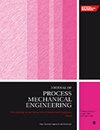Exploring the machining characteristics of aluminum 6061 using nanosecond pulse fiber laser machine
IF 2.2
4区 工程技术
Q2 ENGINEERING, MECHANICAL
Proceedings of the Institution of Mechanical Engineers, Part E: Journal of Process Mechanical Engineering
Pub Date : 2024-08-28
DOI:10.1177/09544089241276337
引用次数: 0
Abstract
The present study aims to probe the influence of nanosecond laser parameters on the surface quality of aluminum material (Al 6061) using a full factorial design approach. Additionally, the study utilizes the Harris Hawks optimization (HHO) algorithm to determine the optimized laser parameters for achieving desirable surface features on straight-cut aluminum samples. Subsequently, the machined samples are analyzed through optical microscopy, scanning electron microscopy (SEM), and energy dispersive spectroscopy (EDS). The evaluation criteria for the present study are taper, surface roughness, and heat-affected zone (HAZ) thickness. The results revealed that average laser power significantly impacted the taper (17.01%), and scanning speed contributed significantly to the taper (26.62%). The average power and scanning speed combined showed the most substantial influence on taper (47.76%). Furthermore, the average power had the most significant effect on the heat-affected zone (77.76%) and surface roughness (SR) (72.22%). The optimal conditions determined by the HHO were a pulse frequency of 100 Hz, a scanning speed of 10 mm/s, and an average power of 40 W, resulting in heat-affected zone = 36.047, surface roughness = 5.496, and taper angle = 23.188. These findings hold significant implications for enhancing the surface characteristics of aluminum in laser machining processes, thereby benefiting industries such as aerospace, automotive, and electronics.使用纳秒脉冲光纤激光加工机探索铝 6061 的加工特性
本研究采用全因子设计方法,旨在探究纳秒激光参数对铝材料(Al 6061)表面质量的影响。此外,本研究还利用哈里斯-霍克斯优化(HHO)算法确定优化的激光参数,以便在直切铝样品上获得理想的表面特征。随后,通过光学显微镜、扫描电子显微镜(SEM)和能量色散光谱(EDS)对加工样品进行分析。本研究的评估标准是锥度、表面粗糙度和热影响区(HAZ)厚度。结果显示,平均激光功率对锥度的影响很大(17.01%),扫描速度对锥度的影响很大(26.62%)。平均功率和扫描速度之和对锥度的影响最大(47.76%)。此外,平均功率对热影响区(77.76%)和表面粗糙度(SR)(72.22%)的影响最大。HHO 确定的最佳条件是脉冲频率为 100 Hz,扫描速度为 10 mm/s,平均功率为 40 W,结果热影响区 = 36.047,表面粗糙度 = 5.496,锥角 = 23.188。这些发现对于在激光加工过程中提高铝的表面特性具有重要意义,从而有利于航空航天、汽车和电子等行业。
本文章由计算机程序翻译,如有差异,请以英文原文为准。
求助全文
约1分钟内获得全文
求助全文
来源期刊
CiteScore
3.80
自引率
16.70%
发文量
370
审稿时长
6 months
期刊介绍:
The Journal of Process Mechanical Engineering publishes high-quality, peer-reviewed papers covering a broad area of mechanical engineering activities associated with the design and operation of process equipment.

 求助内容:
求助内容: 应助结果提醒方式:
应助结果提醒方式:


